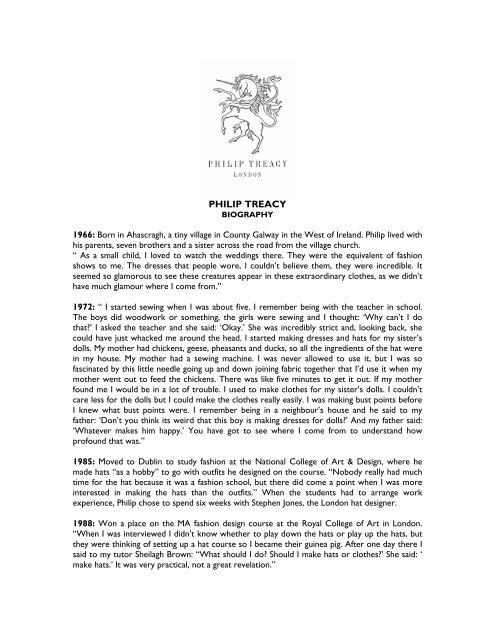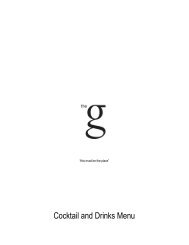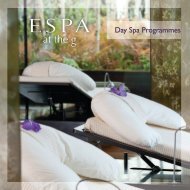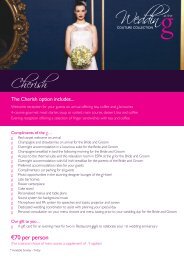PHILIP TREACY - The G Hotel
PHILIP TREACY - The G Hotel
PHILIP TREACY - The G Hotel
- No tags were found...
You also want an ePaper? Increase the reach of your titles
YUMPU automatically turns print PDFs into web optimized ePapers that Google loves.
<strong>PHILIP</strong> <strong>TREACY</strong>BIOGRAPHY1966: Born in Ahascragh, a tiny village in County Galway in the West of Ireland. Philip lived withhis parents, seven brothers and a sister across the road from the village church.“ As a small child, I loved to watch the weddings there. <strong>The</strong>y were the equivalent of fashionshows to me. <strong>The</strong> dresses that people wore, I couldn’t believe them, they were incredible. Itseemed so glamorous to see these creatures appear in these extraordinary clothes, as we didn’thave much glamour where I come from.”1972: “ I started sewing when I was about five. I remember being with the teacher in school.<strong>The</strong> boys did woodwork or something, the girls were sewing and I thought: ‘Why can’t I dothat?’ I asked the teacher and she said: ‘Okay.’ She was incredibly strict and, looking back, shecould have just whacked me around the head. I started making dresses and hats for my sister’sdolls. My mother had chickens, geese, pheasants and ducks, so all the ingredients of the hat werein my house. My mother had a sewing machine. I was never allowed to use it, but I was sofascinated by this little needle going up and down joining fabric together that I’d use it when mymother went out to feed the chickens. <strong>The</strong>re was like five minutes to get it out. If my motherfound me I would be in a lot of trouble. I used to make clothes for my sister’s dolls. I couldn’tcare less for the dolls but I could make the clothes really easily. I was making bust points beforeI knew what bust points were. I remember being in a neighbour’s house and he said to myfather: ‘Don’t you think its weird that this boy is making dresses for dolls?’ And my father said:‘Whatever makes him happy.’ You have got to see where I come from to understand howprofound that was.”1985: Moved to Dublin to study fashion at the National College of Art & Design, where hemade hats “as a hobby” to go with outfits he designed on the course. “Nobody really had muchtime for the hat because it was a fashion school, but there did come a point when I was moreinterested in making the hats than the outfits.” When the students had to arrange workexperience, Philip chose to spend six weeks with Stephen Jones, the London hat designer.1988: Won a place on the MA fashion design course at the Royal College of Art in London.“When I was interviewed I didn’t know whether to play down the hats or play up the hats, butthey were thinking of setting up a hat course so I became their guinea pig. After one day there Isaid to my tutor Sheilagh Brown: “What should I do? Should I make hats or clothes?’ She said: ‘make hats.’ It was very practical, not a great revelation.”
1989: Philip took one of his hats to Michael Roberts, fashion director of Tatler magazine, and hisstyle editor, Isabella Blow.“Our conversation that day was like twenty seconds and I thought nothing of it. A few weeksafterwards, the secretary at the college said: ‘Some Lady has been phoning up. She wants toknow what your schedule‘s like for the next six months.’ I didn’t know what she was talkingabout, but it turned out to be Issie. Issie was getting married and had decided I was going tomake a hat for her.” Having chosen a medieval theme for her wedding dress, Issie asked Philip tomake an appropriate head dress. “I wanted to base the hat on a 1930’s play called <strong>The</strong> Miraclewhich Lady Diana Cooper was in. I suggested to Issy that maybe this would be good for thewedding. I couldn’t believe that I’d hit upon a person who didn’t expect tulle and veiling andpearls for her wedding hat.”1990: Graduated from the Royal College with first class honours and set up a workshop in thebasement of Issy and Detmar Blow’s house on Elizabeth Street Belgravia.“ Issy was living upstairs with her resident hat maker in the basement working away all nightlong coming up with goodies. Suddenly all these wild people pitched up at all hours of the nighttrying on hats. Issy and I were like Harold and Maude trekking around London in a car. We’d goto an exhibition, or go to visit someone. We’d go and get books. We’d go and have a drink. Andall our talk was of hats.”1991: Summoned to Paris to meet Karl Lagerfeld, chief designer at Chanel. “I was 23 and I’d justleft school, I didn’t know whether to call him Mr Lagerfeld or whatever. I was totally intimidatedbut Issie was exactly herself. She just walked into the house of Chanel and said: We’d like sometea please.” Philip went on to design hats for Lagerfeld at Chanel for ten years. <strong>The</strong> first hat hedesigned was the twisted birdcage, photographed by Patrick Demarchelier and worn on thecover of British Vogue by Linda Evangelista. Philip won his first British Fashion Council award asBritish Accessory Designer of the year.1992: Won his second British Designer of the year award (Philip was to win three more) andstarted designing hats for the High Street.“Hats are for everyone. We all have a head so we have the possibility to wear a hat. You feelbetter for wearing them. I was happy to be able to make hats that anyone could afford.” ThatNovember, a friend gave Philip the gift of a puppy. “<strong>The</strong> pup I was supposed to have was thispretty Jack Russell cross called Linda. Trailing behind her was her brother. A beautiful thing.Tiny. <strong>The</strong> size of two mugs. Pale pink with a black spot. I couldn’t resist him, so I said, ‘I’d reallylike that one. When I took him out people would ask what he was, and I’d say he was a pigletbecause he was so pink and sleek, so I called him Mr.Pig.”1993: Staged his first fashion show- all black hats- in the Harvey Nichols department storeduring London Fashion Week. <strong>The</strong> supermodels of the era- Naomi Campbell, Yasmin Le Bon,Kate Moss, Stella Tennant and Christy Turlington- all modelled for him.“I phoned up Christy Turlington to say that I was having a show and would she do it for me? Sheagreed and the rest followed on. Naomi Campbell’s agent called the next day. Kate Mosscomplained that I hadn’t asked her. London was in a lull then. <strong>The</strong> media went crazy when allthose girls did my show and it completely changed perceptions of the hat.”Began working with Gianni Versace and Valentino.
1994: Opened his own shop at 69 Elizabeth Street.“It’s a little gold box with our window to the world. Our customers are everyone from a younggirl who’s saved up for a £150 rainwear trilby to this very distinguished gentleman of about 70.He comes in every summer to order 20 Couture hats to entertain the ladies who will be stayingon his yacht. It doesn’t matter how much people pay for them: everyone wants to look a milliondollars in a hat.”1996: Exhibited in the Florence Biennale, fashion meets art. Philip collaborated with furnituredesigner Tom Dixon.“It was interesting but it took me a while to get over my embarrassment because I thought ofart as a sacred cow. I make hats, not art. But Franca Sozzani (editor of Italian Vogue) asked meto do it and Franca is like Issie and Sheilagh Brown- one of those people you never say ‘no’ to.”1997: Staged his first show in New York.Launched an accessory collection of stingray bags and gloves, geometric and laser cut leather.Work included in the cutting edge Exhibition at the Victoria & Albert Museum, London. <strong>The</strong>accessories sell all over the world.1998: Exhibited in addressing the century at the Hayward Gallery and satellites of fashion at theCrafts Council, both in London.1999: Designed hats for Alexander McQueen’s white Haute Couture collection at Givenchy inParis, which included the gilded ram’s horns from Issie’s Soay sheep (of Spanish blood to maketheir horns more curly) and also designed for Karl Lagerfeld at Chanel. “Having studied fashiondesign it helped me greatly when I started working with designers because I understood howthe clothes draped or moved and the proportions. What I didn’t understand as a student wasthat fashion isn’t clothes, fashion is much more interesting than that, it’s a feeling and a moodnot dress-making.”Staged his second show in New York.2000: At the invitation of the chamber syndicale de la Haute Couture, staged the orchidcollection, the first ever Haute Couture show in Paris devoted to hats.September: Hat Block exhibition Unlikely Sculpture, London.2001: Collaborated with the artist Vanessa Beecroft on an installation at the Venice Biennale.“Another Franca Sozzani gig. She phoned up and said would I make so many masks for thisartist, Vanessa Beecroft, by such a date. By chance, I was flying to New York the next day, so Imet Vanessa while I was there. She was planning an installation of naked girls wearing Blackleather masks. It sounded rather S&M, which isn’t really me, so I said: ‘Why not make the maskstranslucent to enhance the femininity of the wearers?’April: Irish Museum of Modern Art exhibition Unlikely sculpture, Dublin.October: Fondazione Nicola Trussardi Unlikely Sculpture, Milan.2002: Won the Moet & Chandon award for luxury and exhibited the hats credited for IsabellaBlow in When Philip met Isabella at the Design Museum in London with the launch of the firstPhilip Treacy book published by Assouline to catalogue the exhibition.
2003: January: Paid homage to Andy Warhol with his third Haute Couture Show in Paris.February: Launch of the Limited Edition Andy Warhol waterproof accessory range availableworldwide.April: When Philip met Isabella exhibition began its world tour opening at the Melbourne FashionFestival and then to the Power House museum in Sydney.October: Presented with <strong>The</strong> Dream Weaver award by the Fashion Group International alongside Jean Paul Gaultier, Dolce Gabbanna and Donna Karen in New York.2004: Philip is now taking his aesthetic into other disciplines, using his sculptural forms as amedium for other objects, such as glass wear and furniture.September: Launch of the Portrait Chair, part of Habitat's 40th Anniversary project.November: Presented with International Designer of the Year at the China Fashion Awards inShanghai. This was followed by a twenty-look couture show with top Chinese super models andAlek Wek.''I was honoured to be recognised by a culture rich in hats and headdress'. Glamour is a worldwide currency.''2005: Philip was appointed design director for the interiors of Monogram <strong>Hotel</strong>'s flagshipproperty, <strong>The</strong> G. Working alongside Douglas Wallace Architects and Designers this hotelopened in July.''I am a perfectionist and like to create pieces that people love to wear. With <strong>The</strong> G, we willapply the same principles and create a place where people will love to be.''April: Philip created the hats for the wedding of HRH <strong>The</strong> Prince of Wales and Camilla ParkerBowles.2006: Philip Treacy for Umbro launches at London Fashion Week. <strong>The</strong> collection is a fusion ofthe two brands and delivers a complete package of men's clothing that is a synthesis of bothbrands' strengths and demonstrates: glamour, colour, shape, quality, movement andperformance.<strong>The</strong> collection combines all these elements, and the design, attention to detail, fabrication andcut, make it the ultimate expression of luxury fashion and performance wear.“I felt sportswear lacked in style, I wanted to design a collection that is both functional andstylish. Sports wear is a language in fashion today.”April: Philip is given an Honorary Doctorate, honoris causa, by <strong>The</strong> National University of Ireland.“I make hats because I love hats. It‘s an enigmatic object that servers the human purpose onlyof beautification and embellishment and making one feel good whether you’re the observer ofthe spectacle or the wearer.A hat is a positive symbol. A good hat is the ultimate glamour accessory. It thrills observersand makes the wearer feel a million dollars. This creates a high status of desirability andalthough the images received can seem out of this world the conspicuous consumer relatesstrongly to it. <strong>The</strong> message is simple and absolute, a great hat exists outside it’s own time.I believe in beauty and elegance and communicating thoughts and dreams in a visual way. Istarted designing hats 15 years ago while a student at the Royal College of Art. It was at a timewhen hats were perceived publicly as something worn by ladies of a certain age, and somethingfrom a bygone era. I thought this was totally ridiculous and simply believed “we all have a head,so everybody has the possibility to wear a hat.” I love to work with my hands making somethingfrom nothing – turning 2 dimensional material into a 3 dimensional object is the penultimatemoment of creativity of my craft. I have had the greatest pleasure of having the opportunity tochallenge people’s perception of what a hat should look like in the 21 st century.”
May: Philip contributed his Haute Couture Orchids to the anglmania exhibition at <strong>The</strong>Metropolitan in New York. Over the past 30 years, British fashion has been defined by aknowing and self-conscious historicism. In their search for novelty, designers have looked topast styles with an appetite that is as audacious as it is rapacious. Focusing on their historicizingtendencies, AngloMania presented a series of tableaux based on Britain’s literary and artistictraditions.2007: Isabella Blow sadly died on 7 May 2007. <strong>The</strong> legend that enthralled fashionistas with heruncanny ability to spot trend, discover models, and unearth new designers is mourned by anindustry that has inexplicably lost a muse with whom there was never a dull moment. Her tastewas unorthodox and her style was uncompromising. <strong>The</strong> Stylist, muse and taste maker IsabellaBlow was a true original.“Isabella was the first extraordinary interesting person I met in this country when I moved herefrom Ireland. In 20 years I have met all my heroes and nobody in my honest true estimationsurpassed her. She was incredible. I thought there must be others like her, but there wasn’t.Everyone was boring in comparison to her. I will miss her laugh, her passion and her humanity. Iwent to my studio today and Isabella is everywhere. In every hat I made, every corner I turn –she is there. I will always miss her.”June: For the first time Philip Treacy presented a fashion show within the BessboroughRestaurant during Royal Ascot. <strong>The</strong> exhibition When Philip Met Isabella travelled to <strong>The</strong> MarblePalace in St Petersburg. It was opened with a dramatic 50 look show in the Astoria <strong>Hotel</strong>.September: Philip collaborated with Ralph Lauren, Donna Karen, McQueen and Rifat Ozbek fortheir spring summer 2008 shows.November: Philip’s first ever solo show in Ireland at <strong>The</strong> G hotel in his home county of Galway.Philip is appointed as an honorary Officer of the Most Excellent Order of the British Empire(OBE) awarded by HRH Prince Charles and HRH <strong>The</strong> Duchess of Cornwall in Clarence Housesurrounded by his family. <strong>The</strong> honour was conferred on Philip by Her Majesty <strong>The</strong> Queen inrecognition of his services to the British Fashion industry.2008: Designed and photographed the Royal Ascot advertising resulting in a sell out week. Aswell as presenting his Couture designs again in the Bessborough Resturant.Commissioned by Italian Vogue Gioello to photograph specially designed hats and jewellery onDaphne Guinness.Designed and art directed Grace Jones’ first concert in 20 years at <strong>The</strong> Royal Festival Hall forthe Massive Attack Meltdown Festival.2009: Designed and art directed the first leg of Grace Jones’ Hurricane tour beginning inAustralia and finishing in the UK.











